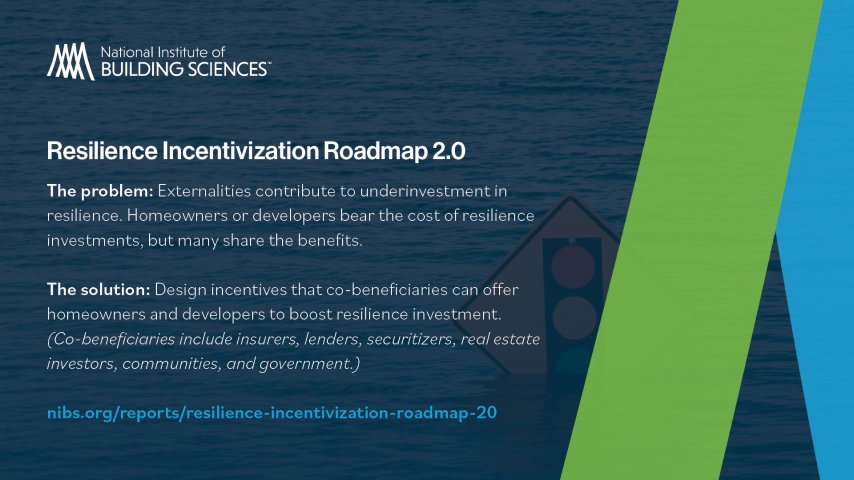
By Christine Cube
In September, NIBS and Fannie Mae unveiled the Resilience Incentivization Roadmap 2.0 – a continuation of a 2020 study that called for public and private incentives that allow owners of buildings and other infrastructure to facilitate the upgrade of existing infrastructure and better design of new infrastructure.
Led by the NIBS Multi-Hazard Mitigation Council’s Committee on Finance, Insurance, and Real Estate (CFIRE), Roadmap 2.0 maintains the same goal: To have stronger and safer buildings and resilient communities by catalyzing collaboration across the building science, finance, insurance, and real estate industries and increase mitigation investment and develop coordinated resilience guidelines and tools for community implementation.
On October 18, 2023, the National Institute of Building Sciences hosted a webinar to discuss the Resilience Incentivization Roadmap 2.0. The panel included Dr. Keith Porter, Chief Engineer, Institute for Catastrophic Loss Reduction; Sean Kevelighan, President & CEO, Insurance Information Institute; Jeff Dunsavage, Senior Research Analyst, Insurance Information Institute; Dr. Sean Becketti, Principal, Elliott Bay Analytics; and Dr. Jiqiu (JQ) Yuan, Vice President, Engineering, NIBS. Mira Papinova, NIBS Project Manager, served as moderator.
CLOSING THE RESILIENCE INVESTMENT GAP
Natural hazards are growing in severity and getting more expensive. To date, disasters annually cost the nation an average of $120 billion annually; this cost doubles every 12 years, growing 10 times faster than the population.
According to Porter, this essentially is like wiping out four weeks of construction value each year.
“That four weeks will get longer and longer,” Porter said. “It is unsustainable.”
Porter said the mission of the Resilience Incentivization Roadmap 2.0 is to “help close the resilience investment gap partly by leveraging private investment funds.”
He then pointed to several key findings in the Resilience Incentivization Roadmap 2.0:
- Mitigation saves, but it does so unequally, often with the owner or developer bearing the cost while others enjoy the benefits.
- Co-beneficiaries rarely collaborate to help pay for resilience, so they lose the opportunity to share billions of dollars of potential savings and increased market value.
- Public-private coordination is essential for society to realize most of the benefits that better buildings could deliver.
WHAT’S NEXT
The project team agrees that the logical next step would involve a pilot study, using a real-world example.
The Institute for Catastrophic Loss Reduction’s Porter said a good candidate for this real-world example would be a mid-sized community that already offers one kind of incentive or grants.
“The organization funding those grants could be the channel for additional incentives,” Porter said. “This would be a community who has a good relationship with one kind of incentive offerer, maybe a local insurer.”
Kevelighan, with the Insurance Information Institute, added: “When the community gets behind the program – this is where we’ve seen success.”
Read the full session paper from the webinar.




